What is the riskiest, most dangerous country in the world? That depends on how you measure risk. Do you consider a tornado more threatening to your business than a computer network hack? Perhaps you believe kidnapping is more life-endangering than the potential for workplace violence. One’s risk perspective tends to be viewed as being subjective. That being said, we’ve long believed risk can be measured and we set out to do just that. The result? Our recently released World Risk Index report. Based on our findings, this post will examine why some countries were determined to be at higher risk or more unsafe to conduct business…and in what ways…than other countries.
What is risk?
In a past post, we examined the difference between risk, threats, and vulnerabilities. Recapping, risk is defined as factors that prevent organizations from achieving their objectives. The potential for a tsunami is a threat for coastal Japan, for example. The likelihood that you will be impacted by a threat is the probability. Therefore Risk equals Threat x Probability x Business Impact. If your company operates far inland from the Japanese coast, the tsunami threat is still present but the probability that a storm will affect you is less. However, if your building is a single-story structure built decades ago and not up to current safety standards, you have created a vulnerability to the tsunami and the potential business impact is greater if the tsunami were it to reach your building. It’s important to understand these distinctions while looking at the world’s riskiest and most dangerous countries because they determine to what degree you are putting your business value in harm’s way when operating in these regions.
The world’s riskiest & most dangerous continent: Africa
While the full Risk Index Report details the results and the methodology we used in determining risk across the globe, a quick look at Pinkerton’s World Risk Map will visually tell you the story quickly: Africa is the riskiest continent for business on the planet.
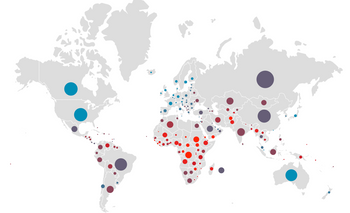
The countries in red indicate the highest risk levels in the world.
The list of the Top 10 Riskiest Countries based on overall risk is:
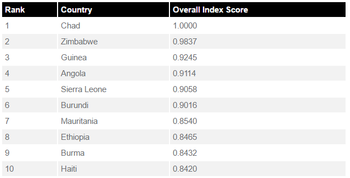
All but the last two on the list, Burma and Haiti, are on the African continent. In general, this means that doing business in these countries should be done cautiously and with detailed planning. But understanding the nature of the risks and dangers, and to what degree there are real threats to you, your employee and your business requires more detailed examination.
Comparing Risks
For the report, we used our Pinkerton Risk Wheel to separate risks into four categories:
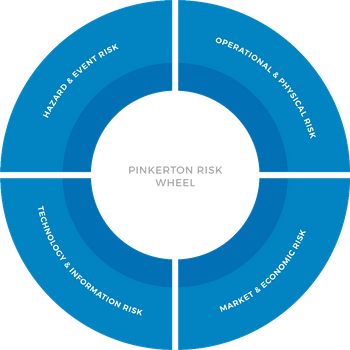
Further, we then broke down each major risk within the quadrants:
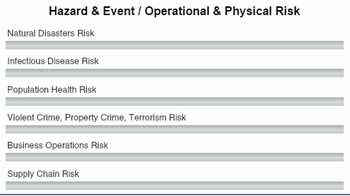
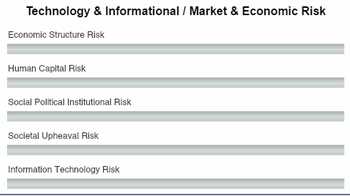
While looking at this list, perhaps you are already weighing which risks would have a greater impact on your business and which would have less. That’s a good start. Next, though, you need to know whether the most impactful risks are present in regions you are considering for expansion and/or employee travel. As an example, let’s look at Chad, located in Central Africa, which the report determined was the world’s riskiest country.
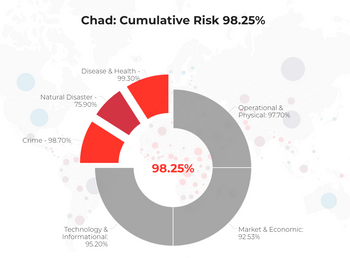
Nearly all of the categories are in or approaching red levels, the highest level of risk. To put this into perspective, let’s look at Canada, deemed one of the safer countries in the report.
-350.png)
Deciding whether to operate a business in Chad versus Canada, based on risk factors, seems pretty straightforward. However, it gets trickier when you consider countries that have a higher risk in some categories and lower risk in others; Argentina is a good example of that.
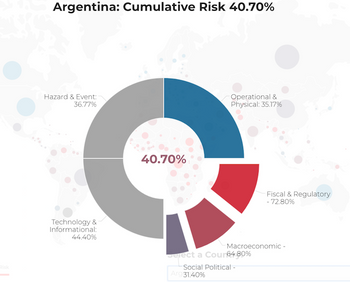
Argentina may be a market that has great potential for your products or services, but does it present high risks or dangers for employees? The risk of infectious disease is low but violent crime risk is very high. And what is the overall risk to your business? Business Operation risk is also high while overcrowding (Population Health Risk) and Societal Upheaval are both low. These are all factors requiring consideration before making decisions that could have long-lasting impacts.
As you can tell by just these few examples, risks vary greatly by continent and country. And, those risks are changing all the time. A risk assessment can provide up to date insight before you make a decision about international expansion or sending executives/employees to certain markets. Another tool you can take advantage of is Pinkerton Insights, our free daily e-mail service that provides you with event and analysis that affect international business.
Well-researched intelligence can be the most powerful weapon you have to mitigate risks, reduce threats and eliminate vulnerabilities.





